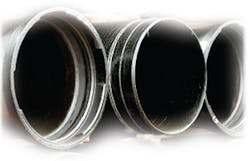Addressing the Problem of Failing Septic Systems
By David Putnam
Most of us in the Water Works Industry are familiar with the documentary titled Liquid Assets, which details and exposes the aging water infrastructure in this country and the potential harm that could result unless billions of dollars are invested in its repair over the next decade. While it was not a complete surprise to us in the industry, the detail and depth of the piece was eye-opening to even the most experienced water works professional.
Imagine now part two of this documentary, titled Sedimentary Assets: A Look at Our Failing Sewer Systems. This piece would examine the history and aging of our country's septic and sewer systems. While Liquid Assets looked to protect a single asset, clean and plentiful drinking water, Sedimentary Assets would examine the effects of septic failure on such very precious assets as the ground, groundwater, surface water and our wetlands.
Our methods for containing and processing waste have evolved from the most primitive to today's technologically advanced systems. The earliest systems, using open trenches, relied solely on the natural filtering of the ground. Fortunately for us, the ground itself is a good, natural filter of septic waste. But this method allowed bacteria into the air which led to disease. The cesspool was an improvement which successfully enclosed the septic discharge and kept the bacteria away from the open air and let the ground continue to do its work. This basic design was used until well past the post Civil War era.
The first "sewer interceptor" systems in the United States used mostly brick or wood for the collection system and wood was also used for the inverts and clay for the covers or "crowns".
The city of Boston used one system of log sewer pipes for decades and well into the late 1800s. Our nation's Capital was one of the first areas to use sanitary sewers made from unlined concrete and clay tile pipe. Collection systems were an improvement, but large populations overworked the systems which led to raw sewage being dumped into the nation's waterways.
Widespread and devastating illnesses from contaminated water plagued large cities throughout the country. One such epidemic hit in Memphis, TN, around the turn of the last century and over 10,000 lives were lost to yellow fever and cholera.
Such epidemics led to the realization that all that enters our septic systems has a huge impact on our surroundings, and ultimately our health and sustainability.
Improvements continued in the 1900s and today we now have treatment plants and systems that can just about produce potable drinking water. Treatment plant discharge is now so clean it can be used to recharge aquifers, sustain water tables, and maintain surface water levels.
Our industry has come a long way from its rudimentary beginnings but more remains to be done. Old systems need to be replaced or we risk experiencing the same problems of old. Fortunately, our government has recognized the dangers of our aging systems and slated a portion of the Federal Stimulus package of 2009 for such projects in hopes that the financial windfall can continue to correct centuries of damage to the eco-system.
The February 17, 2010, deadline for obligating 100 percent of ARRA formula funds is fast approaching. All money earmarked for Clean Water & Safe Drinking water project must be under contract by that date or it will be reallocated.
Getting projects prepared, approved and under contract has been a struggle.
Just over half of the $6 billion included in the State Revolving Loan programs had been distributed by the first week of January. Distribution has been an integral part of this supply chain for many years and a backbone to the sewer industry. The Water and Sewer Distributors of America pride themselves on being in position to help the public official, the engineer, and the installation contractor. Our organization continues to evolve in size and exposure in bringing the right products to the market for a variety of solutions.
Clean and plentiful water issues will continue to be imperative to our survival, but the sewer industry will continue to keep us on our toes. Our Government Relations Committee has contact with Washington, DC, and is a Silver Sponsor of the Clean Water Council under NUCA. We look forward to future legislation and funding of projects to continue the effort to keep our water clean.
There are several agencies involved when with any municipal grant or project. In the state of Massachusetts alone, the design engineer, installation contractor, and material supplier have to deal with several different organizations when working on a sewer system expansion project before they even get a shovel into the ground. For example, utilities must prepare a Comprehensive Wastewater Management Plan (CWMP), in conjunction with the Water Management Act, under the guidelines and the watchful eye of the Massachusetts EPA, to make maintain the standards required by the Interbasin Transfer Act (IBTA). Then and only then, are we sure that our system has achieved the level of improvement satisfactory for the NPDES and Natural Heritage & Endangered Species Program (NHESP), and hopefully fits within the ARRA framework, so the work can really begin.
It seems providing the pipe for these projects might just be the easy part. WW
About the author:
David Putnam, Putnam Pipe Corp., is WASDA Publications Committee Chair.
More WaterWorld Current Issue Articles
More WaterWorld Archives Issue Articles

